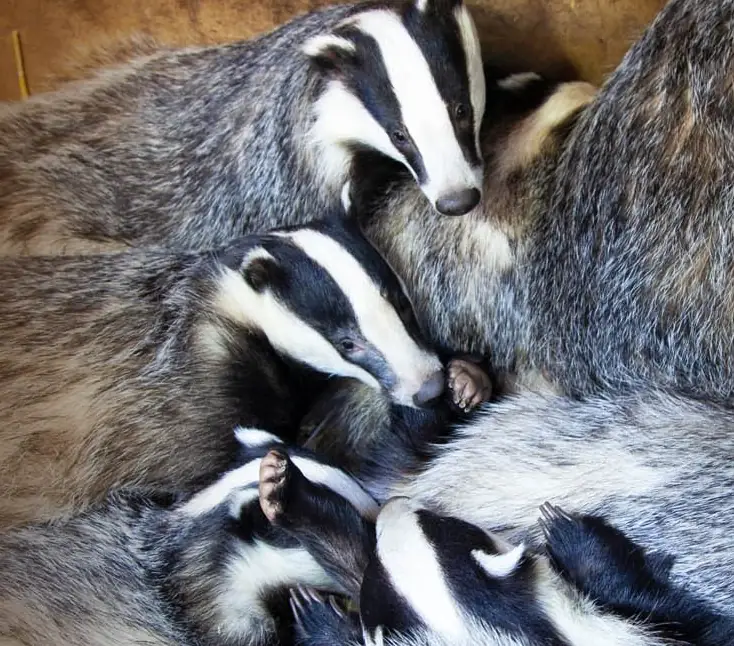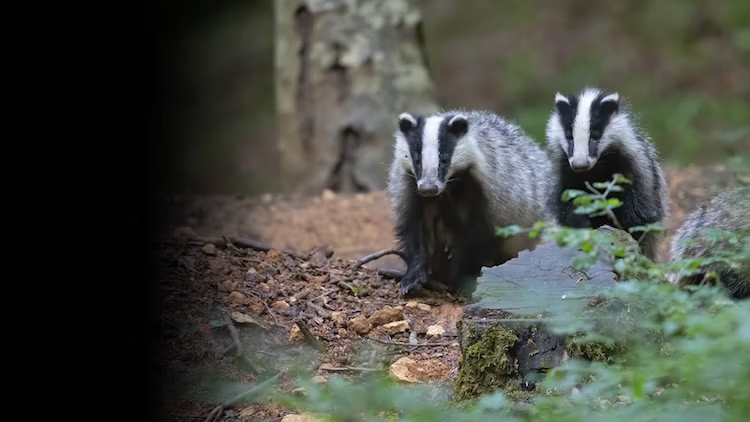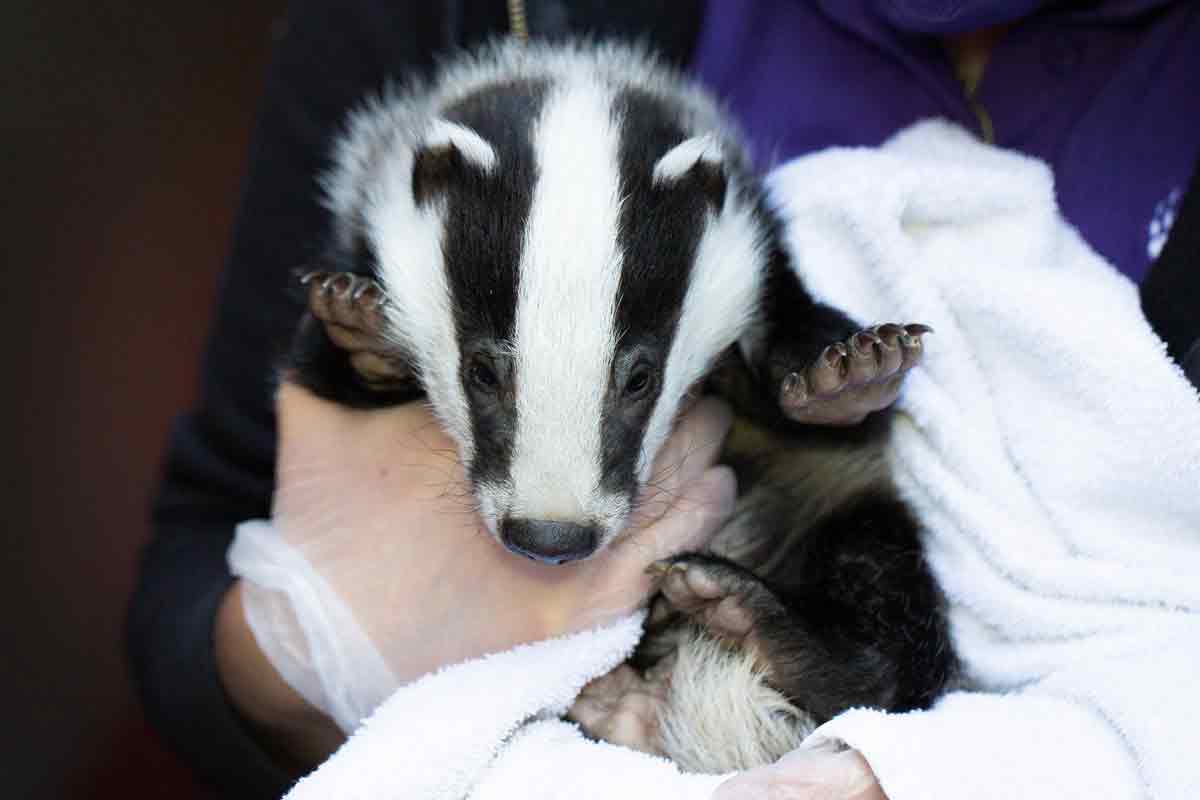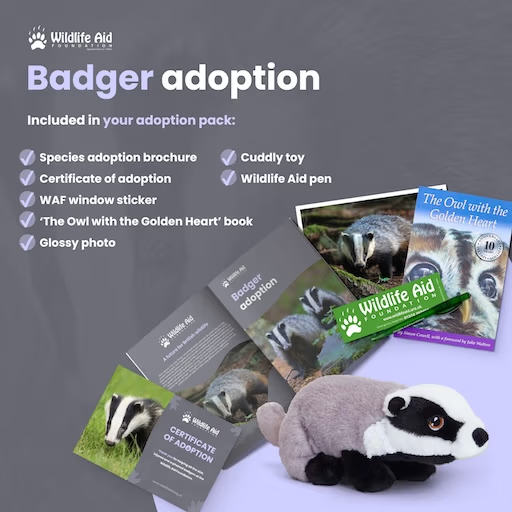European Badger
Meles meles
Life History
Length: 75-100cm
Tail: 15cm
Weight: 7-13kg (in spring) 15-17kg (in autumn, ready for winter torpor)
Diet: Omnivorous; around 80% of their diet consists of earthworms, outside of earthworms they will eat: fruits, cereals, small rodents, slugs, and other invertebrates. When desperate for food, they have been known to prey on hedgehogs.
Average Lifespan: 5-8 years
When to see them: All year round, but less active over the winter period.
UK population: 357,000 (est in 2018)
UK conservation status: Protected in the UK.

About
Badgers are the UK’s largest land predator and are one of the most well-known British species. They are famous for their black and white stripes, and flat, stocky bodies. But don’t be deceived by their cuddly looks, these powerful and stocky animals pack quite the punch and could cause serious injury to a human – you do not want to mess with a badger!
Badgers are nocturnal and rarely seen in the day, however, during the warm summer weather they may emerge from the sett a short while before sunset. They tend to live in groups, although do not always act cooperatively with their fellow clan members.
Their Threats
Habitat Loss: This is a common theme for all UK wildlife. Badgers are no exception, and their territory is continuously impacted with land development and the introduction of additional roads.
RTA (Road Traffic Accidents): As badgers are a nocturnal species, roads are a real threat to them. It is estimated that up to 50,000 badgers are killed on the UK’s roads, every year, which equates to 137 deaths per day, or 5 per hour.
Culling: The badger cull is a serious threat to wild badger populations. There is an estimated 400,000 to 500,000 badgers in the UK. The cull, when finished, could see over 50% of this population killed.


How you can help
There are a number of simple ways you can help badgers:
- Plant fruit trees and shrubs early to provide a food source and avoid using pesticides to encourage invertebrate abundance
- Slow down on roads, especially around dusk and dawn
- Keep a note of a local wildlife rescue in case you find an injured or orphaned badger
- Sign petitions to stop the cull, find out more at badgertrust.org.uk
Frequently Asked Badger Questions
There is an injured badger in my garden, but it runs off when I approach it
Unfortunately, like most wild animals, a badger will try to avoid capture no matter the injury it may be suffering with. The best way to help the badger is to try and identify the injury; are they holding or dragging a leg? Can you see any obvious swelling or open wounds to any of the legs or body? If there are open wounds do they look deep, inflamed or infected?
A badger that is mobile are incredibly difficult to catch, and the majority of our badger admissions are a result of being trapped in one way or another.
I don't want badgers in my garden. How can I get rid of them?
As badgers are protected by law, it is an offence to disturb, destroy or tamper with an active badger sett, without a licence.
There are humane ways you can deter badgers, please visit www.humanewildlifesolutions.co.uk for more information.
I think I've found an orphaned badger cubs
If the cub doesn’t appear to be injured, is routinely calling and warm to the touch, monitor the cub for a short while from a distance, the parent may have dropped the cub whilst moving it, and may still be close by.
Due to the number of factors that need to be considered when finding a badger cub, the best port of call is to give us a call so we can triage the situation appropriately. Our emergency helpline is 01372 360404.
There is a badger entangled in wire, what should I do?
Do not attempt to free the badger yourself, they are very dangerous. Also, do not go too close to the badger, as it can cause it to become very stressed and possibly do itself more damage. Please, call us and we will send a rescuer.
I have found a dead badger by the roadside, what should I do?
Please, contact your local council, who will advise you on how to dispose of it; some councils may come and collect. Otherwise, you can put it into an overgrown area, and let nature take its course, which is the best option.
If the badger is found during the period January – April, please, check to see if there are teats, to see if it is a female, and to see if there are any signs that she may have young – heavy, drooping nipples or milk escaping (lactating). If you see any of these signs, there may well be young, nearby. Please, contact the Wildlife Aid Foundation, your local wildlife centre or your local badger group. In Surrey, this will be the West/East Surrey Badger Group, who will go out to search for signs of a sett and listen out for the call of young.

What’s included in your badger adoption pack
Not only will you be providing invaluable care and helping countless animals, but you will also receive an exclusive badger adoption pack, including cuddly toy, species brochure, certificate of adoption, photo and more. NOTE: The pack will include either ‘The Owl with the Golden Heart’ book or ‘Wildlife SOS’ book, dependent on stock.